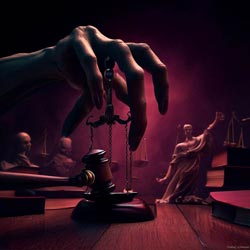 In the heart of the American legal landscape, where justice should shine as a beacon of truth, an unsettling cloud of doubt lingers, casting a pall over the integrity of the highest echelons of the judiciary. The Supreme Court stands as a symbol of the nation's highest ideals, safeguarding justice and upholding the Constitution. Its decisions reverberate through history, shaping the course of laws and lives. Unfortunately, the Supreme Court finds itself enshrouded in shadows. These shadows are not merely a play of light; they are the harbingers of a fundamental crisis that threatens to erode the very foundation of justice.
In the heart of the American legal landscape, where justice should shine as a beacon of truth, an unsettling cloud of doubt lingers, casting a pall over the integrity of the highest echelons of the judiciary. The Supreme Court stands as a symbol of the nation's highest ideals, safeguarding justice and upholding the Constitution. Its decisions reverberate through history, shaping the course of laws and lives. Unfortunately, the Supreme Court finds itself enshrouded in shadows. These shadows are not merely a play of light; they are the harbingers of a fundamental crisis that threatens to erode the very foundation of justice.
In the midst of these shadows, we embark on a journey that seeks to explore the intricacies of the Supreme Court's ethical landscape, to peel back the layers of its autonomy, and to examine the implications of its distinct lack of ethical oversight. As we traverse this landscape of doubt, our exploration delves deep into the ethical void that clouds the Court's actions, and it confronts the need for reform and transparency to reclaim the integrity that justice demands.
At the pinnacle of the United States legal system, the Supreme Court wields immense power, interpreting the Constitution and shaping the legal landscape for generations to come. Its decisions are etched into the annals of history, molding the contours of civil rights, liberties, and the rule of law. This eminent body embodies the nation's collective conscience, standing as a beacon of justice that guides the nation through tumultuous waters. However, in the midst of the Court's majesty, a troubling paradox emerges: the fragility of ethics in the face of gifts and money.
Corruption can insidiously flourish within even the subtlest of actions. The acceptance of money or gifts, however innocuous they may seem, taints the very essence of impartiality and fairness that the judiciary represents. This foundational truth resonates deeply within the context of the Supreme Court. Its unique status and role in shaping the legal landscape of the nation intensify the shadows of doubt that loom overhead. It's a disconcerting paradox where an institution charged with the duty to dispense justice becomes ensnared in skepticism, as the specter of impropriety threatens to erode the core principles it is tasked to uphold.
The very essence of corruption lies in its subtlety. The notion that a simple token of appreciation or a seemingly harmless gift could erode the integrity of justice seems incredulous at first glance. Yet, it is this seemingly inconspicuous acceptance that paves the way for a far graver erosion of justice. Corruption, like a venomous vine, winds its way through the once pristine halls of justice, entangling the minds of judges and casting a shadow over their judgments. The nexus between a gift and an ulterior motive is elusive, a dance of intentions and perceptions that blurs the lines between impartiality and influence.
At the core of this crisis lies a fundamental truth: corruption is self-proving when judges at any level accept money or gifts, for the mere appearance of impropriety is sufficient to undermine the concept of fairness-under-the-law. This thesis forms the linchpin of our exploration, a journey that will delve deep into the intricacies of the Supreme Court's unique situation and its ramifications for the judicial landscape. The very institution that stands as the ultimate arbiter of justice is paradoxically exempt from the ethical guardrails imposed on its counterparts. This exemption from the standards that guide other judicial bodies sets the stage for an unsettling quandary, where the guardians of justice are held to a different, disconcerting standard.
While judges at various levels are bound by stringent ethical standards, ensuring their actions remain untainted by external interests, the Supreme Court justices stand alone in a void devoid of such guardrails. This vacuum not only undermines the principle of a level playing field but also exposes the chinks in the armor of justice. The absence of internal investigation or review mechanisms grants the Court an unchecked autonomy that can perpetuate corruption without consequence. The discomforting truth is that these guardians of justice lack the guardianship of their own actions.
As we embark on this dark and compelling journey, the sections that follow will unveil the intricacies of this ethical void. We will traverse the terrain of apparent impropriety, examining the relationship between judges, gifts, and the fundamental principles of justice. We will confront the ethical vacuum that the Supreme Court finds itself in, exploring the implications of unchecked autonomy, absent internal investigation, and lack of penalties for ethical breaches. We will question the integrity of an institution that, despite its exalted status, grapples with skepticism and a historical backdrop of low approval ratings.
In the realm of justice, accountability is paramount. A system built on the bedrock of public trust must be transparent and responsive to ensure its credibility endures. Yet, the Supreme Court's immunity to ethical oversight and the Judicial Conference's decisions casts a long shadow of doubt over its integrity. The very institution entrusted with ensuring justice is meted out fairly finds itself ensnared in a contradiction: the power to interpret law without the responsibility to abide by the ethical standards set for others. This glaring incongruity is the heart of the Supreme Court's credibility crisis.
The gavel that symbolizes justice now sounds like an unsettling echo in the chambers of doubt, underscoring the need for profound introspection and reform.
The Apparent Impropriety: Judges and Gifts
Where the scales are meant to remain untainted, even the slightest hint of impropriety can shatter the facade of impartiality. The path to ethical decay often begins with innocuous gestures and seemingly trivial tokens, but it's the shadows that these gestures cast that can taint the very fabric of justice.
From local courts to appellate tribunals, the foundation of a just legal system rests upon the ethical standards that guide judges. These standards, meticulously crafted, serve as a moral compass, ensuring that external influences do not undermine the sanctity of judgments. As guardians of justice, judges across the spectrum are bound by stringent rules, protecting their impartiality and the public's trust in their decisions. But as we ascend the judicial hierarchy, a disturbing anomaly emerges.
Inexplicably, Supreme Court Justices stand as exceptions in a landscape of ethical standards. The bedrock principles that govern judges across the nation seem to crumble under the weight of this unexplainable exemption. These guardians of the Constitution, revered for their wisdom and impartiality, find themselves beyond the reach of ethical boundaries. The question that looms is whether the exalted heights of the Court grant immunity to the corrosion of corruption.
Gifts, seemingly innocent and benign, hold the potential to distort the course of justice in insidious ways. The cases where acceptance of gifts or money could lead to bias and unfairness are not hypothetical constructs; they are woven into the very tapestry of legal history. The connections forged by these tokens create invisible threads that tug at the scales, tilting them toward favoritism and away from the blind pursuit of truth. These distortions undermine the credibility of the judiciary, sowing seeds of skepticism in the minds of those who seek justice.
In a system that relies on public trust, the appearance of impropriety is as damning as an act of impropriety itself.
The principle of justice goes beyond the individual; it extends to the collective faith that society places in the judicial process. When even a hint of impropriety clouds the image of a judge, it casts a long shadow over the concept of fairness under the law. It's not just about the purity of intentions; it's about the clarity of perception. The aura of impropriety, once established, is a specter that refuses to fade away.
It is clear that the shadows of corruption thrive in the gray areas, in the moments when ethics waver and intentions blur.
The Ethical Vacuum: Supreme Court's Unique Situation
Where justice should be the beacon that guides society, an unsettling void exists, undermining the very principles upon which the nation was built. This void is not merely an absence; it's an ethical vacuum that contaminates the hallowed halls of the Supreme Court.
Ethical standards are the backbone of the judicial system, designed to shield justice from the erosive forces of corruption. However, within the highest echelons of the judiciary, these guardrails inexplicably disappear. Supreme Court Justices, while entrusted with monumental decisions that shape the course of the nation, are alarmingly exempt from the ethical constraints imposed on their counterparts in lower courts. The question that resonates is how can the guardians of justice stand exposed, vulnerable to the very influences they are meant to repel?
An ethical vacuum cannot exist in isolation; it's a void that engulfs transparency, accountability, and public trust. The lack of internal investigation and review mechanisms means that the Supreme Court operates in a realm of darkness, untouched by the light of scrutiny. The implications of this darkness ripple beyond the chambers of the Court, casting doubt over the validity of its judgments. The darkness hides not only wrongdoings but also the nagging sense that those responsible for upholding justice might be tainted themselves.
The absence of punishment or penalties for ethical violations is a glaring paradox. The Court's autonomy, while essential in its deliberations, becomes perilous when it shields its members from accountability. The very institution that metes out punishments to others remains immune to its own transgressions. This immunity reeks of injustice, questioning whether justice truly prevails within the Supreme Court's hallowed walls.
The Supreme Court's unchecked autonomy stands as a stark contrast. Other judicial bodies, bound by ethical standards, operate within a system of checks and balances that prevent the corruption of justice. This contrast underscores the uniqueness of the Court's situation and poses a dire question: can an institution that rejects the accountability required of its peers genuinely uphold justice? The answer appears to drift further into the shadows.
As we cast a sanitizing light and pierce the cloak of this unsettling reality, let's further explore the ethical void that threatens the very core of the Supreme Court. We must confront the unsettling questions surrounding the Judicial Conference's limited influence and the crisis of integrity that justifies the Court's low approval rating.
The Judicial Conference's Limited Influence
In the complex maze of the American legal system, the Judicial Conference emerges as a bastion of hope, a body tasked with setting the course of justice, ensuring its fairness and integrity. Yet, even within its exalted role, the reach of its influence remains curtailed, overshadowed by the unyielding autonomy of the Supreme Court. This paradox casts a sinister pall over the very concept of accountability.
The Judicial Conference, by design, serves as the harbinger of federal court policy, steering the nation's legal compass through the intricate waters of justice. Comprised of esteemed chief judges and legal experts, its role is to promote transparency, fairness, and adherence to ethical standards. It is here, within this conference, that the seeds of a robust, accountable judiciary are sown. Yet, the tragic irony is that the wisdom that emanates from this assembly holds little sway over the highest echelons of justice.
While the Judicial Conference's deliberations shape the ethical landscape for federal courts, its decisions prove to be a distant echo in the chambers of the Supreme Court. The Court, perched atop its ivory tower of autonomy, remains resolute in its detachment from the ethical guidelines set forth by its peers. The Judicial Conference's wisdom, forged from years of collective experience, is relegated to the periphery, rendered impotent when confronting the unyielding walls of the Court's independence.
The significance of an independent, accountable judiciary is not a mere abstraction; it is the cornerstone upon which a just society is built. Accountability bridges the gap between power and responsibility, ensuring that the scales of justice remain untainted by external influences. The absence of accountability, exemplified by the Supreme Court's insulation, shatters this delicate equilibrium. An institution that stands as the final arbiter of justice becomes its own exception, defying the very principles it is meant to uphold.
Questioning the Integrity of the Supreme Court
In the hallowed and very secretive corridors of the Supreme Court, where justice should shine as a beacon of truth, an unsettling cloud of doubt lingers, casting a pall over its credibility. As the highest guardian of law, the Court's very legitimacy hinges on its unwavering integrity. Yet, this integrity is now the subject of grim speculation, as the nexus between ethical void and public trust becomes a haunting reality.
The relationship between a fair legal system and public trust is symbiotic, a delicate dance that relies on the belief that justice is meted out without prejudice. The judiciary stands as the last resort for those who seek fairness, its decisions holding the power to reshape lives and shape the course of society. However, as the Supreme Court's ethical vacuum becomes more apparent, the bond between justice and trust begins to fray. A system that fails to uphold its own ethical standards sows the seeds of skepticism, unraveling the very tapestry of justice.
The historical context of the Supreme Court's low approval rating speaks volumes about the erosion of its integrity. The Court, once revered as a bastion of wisdom and impartiality, now grapples with a public perception that stands in stark contrast to its elevated status. It's a jarring reminder that public trust is not a given; it's earned through the consistent display of integrity and accountability. The past echoes with the voices of dissent, narrating a tale of disappointment and disenchantment.
The skepticism that shrouds the Supreme Court's integrity is not born of baseless conjecture; it's rooted in reason and observation. The rationale behind this skepticism goes beyond a mere lack of transparency; it extends to the very structure that allows ethical breaches to go unchecked. An institution meant to interpret and uphold the law should stand as a model of ethical rigor, immune to the taint of bias or corruption. When this immunity is violated, it casts a long, foreboding shadow over every decision handed down from the bench.
Addressing Counterarguments
As the shadows cast by the Supreme Court's ethical vacuum deepen, there are those who would raise their voices in defense of its autonomy. Yet, this defense, while rooted in principles of independence, begs for scrutiny. The edifice of unchecked autonomy, once unassailable, now stands before the scales of accountability.
The allure of defending the Supreme Court's autonomy is a siren's call to safeguard its independence from external influences. Advocates argue that this autonomy is the foundation upon which impartial judgments are built, free from political or societal pressures. The argument whispers that the Court's singular focus on the law should remain untainted by the vagaries of accountability. However, in the face of mounting evidence that this autonomy might nurture corruption rather than quash it, the siren's call finds itself enveloped in a fog of doubt.
While the defense of absolute independence rings with noble intentions, the counterpoint emerges with equal urgency: accountability should not be sacrificed on the altar of autonomy. The very premise that an independent judiciary upholds justice becomes a hollow echo when its actions are immune from scrutiny. History has taught us that unchallenged power often tilts towards abuse, and even the most well-intentioned systems can fall victim to corrosion. The call for accountability is not a cry for interference; it's a plea to safeguard the sanctity of justice.
The dichotomy between judicial autonomy and accountability need not be a stark choice between extremes. There exists a path less trodden, a nuanced approach that harmonizes these principles. Strengthening ethical guardrails, while preserving independence, is not an impossibility. Just as the law evolves, so should the mechanisms that ensure its integrity. Innovative solutions, from external oversight panels to transparency initiatives, can transform the current landscape into a realm where autonomy and accountability coexist.
The Call for Reform and Transparency
In the midst of the unsettling shadows that haunt the Supreme Court's integrity, there emerges a call, a plea for reform and transparency that seeks to pierce the darkness. The time has come to challenge the status quo, to reconstruct the ethical foundations of the highest echelons of justice.
The first step toward reform lies in the reconstruction of the ethical fortifications that have crumbled within the Supreme Court's walls. The establishment of stringent ethical standards, akin to those imposed on lower courts, can serve as a bulwark against the corrosion of corruption. Justices, entrusted with monumental decisions, should find themselves bound by the same ethical constraints that safeguard judges across the nation. By reshaping the very rules that govern their actions, the Court can usher in a new era of accountability and trust.
The autonomy of the Supreme Court need not remain an impregnable citadel; it can be fortified through external oversight and accountability mechanisms. Independent panels, comprised of esteemed legal minds and ethical experts, can serve as the guardians of integrity. These panels, devoid of political biases and vested interests, can scrutinize the Court's actions, ensuring that they align with the principles of justice and fairness. This external gaze, far from infringing on autonomy, can breathe life into an institution at risk of being consumed by its own shadows.
The path to redemption requires more than legal reforms; it demands the rebuilding of public trust and credibility. Transparency initiatives, from live-streaming proceedings to regular reports on ethical standards, can bridge the chasm that separates the Court from the public it serves. Openness can demystify the enigma of justice, fostering a sense of connection and understanding that is crucial for the revival of faith in the judiciary. The Supreme Court, once cloaked in shadows, can emerge as a beacon of hope, reclaimed from the clutches of skepticism.
Conclusion
A stark truth emerges: the integrity of the Supreme Court is an unsettling question mark, a cloud that hovers over the very heart of the American legal system. As we trace the contours of corruption's grip on the highest echelons of justice, the call for reform and transparency resonates with an urgency that cannot be ignored.
Corruption is self-proving when judges at any level accept money or gifts, as the appearance of impropriety alone is enough to taint the concept of fairness-under-the-law. We have navigated through the labyrinth of the Supreme Court's unique situation, where ethical guardrails crumble and the autonomy of justices stands unchallenged. It's an unsettling tale where shadows cast by impropriety blur the lines between justice and favoritism.
The Supreme Court's lack of ethical oversight stands as a testament to a system teetering on the brink of ethical decay. In an environment where even the guardians of justice remain exempt from the standards that safeguard justice at lower levels, the foundations upon which a just society is built begin to crumble. It's a situation where unchecked autonomy gives rise to skepticism, where the scales of fairness tip perilously.
The journey to redemption starts with reforms that bridge the chasm between accountability and autonomy. The reconstruction of ethical standards, the introduction of external oversight, and the embrace of transparency are not just notions; they are lifelines to salvage the integrity of the judiciary. It's a call to restore the sanctity of the Supreme Court, transforming it from an inscrutable institution to an embodiment of justice that holds the trust of the public it serves.
As we step back from the shadows that have tainted the highest court, let us not forget that the conversation surrounding the integrity of the Supreme Court is ongoing. It's a dialogue that requires continued engagement, a relentless pursuit of justice that demands accountability and impartiality. The shadows of corruption can only be dispelled by the collective voice that seeks fairness, transparency, and the unwavering pursuit of truth.
The journey toward a just and credible Supreme Court may be arduous, but the quest for integrity remains an indomitable beacon, guiding us through the darkness. Let this exploration ignite the fires of reform, compelling us to demand a judiciary that upholds the principles it was established to protect.






